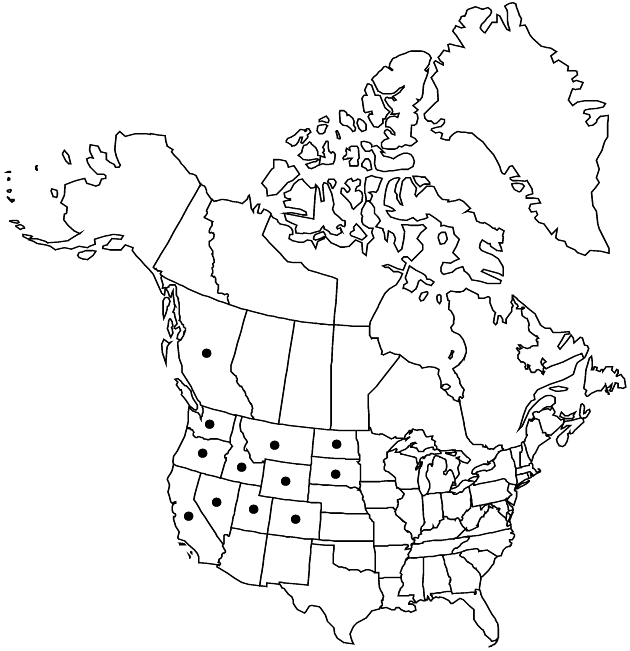Difference between revisions of "Artemisia tridentata subsp. vaseyana"
Rhodora 61: 83. 1959.
FNA>Volume Importer |
FNA>Volume Importer |
||
| Line 8: | Line 8: | ||
}} | }} | ||
|common_names=Mountain sagebrush | |common_names=Mountain sagebrush | ||
| − | |basionyms={{Treatment/ID/ | + | |basionyms={{Treatment/ID/Basionym |
|name=Artemisia vaseyana | |name=Artemisia vaseyana | ||
|authority=Rydberg | |authority=Rydberg | ||
| + | |publication_title=in N. L. Britton et al., N. Amer. Fl. | ||
| + | |publication_place=34: 283. 1916 | ||
}} | }} | ||
|synonyms={{Treatment/ID/Synonym | |synonyms={{Treatment/ID/Synonym | ||
| Line 36: | Line 38: | ||
|elevation=2000–2800 m | |elevation=2000–2800 m | ||
|distribution=B.C.;Calif.;Colo.;Idaho;Mont.;Nev.;N.Dak.;Oreg.;S.Dak.;Utah;Wash.;Wyo. | |distribution=B.C.;Calif.;Colo.;Idaho;Mont.;Nev.;N.Dak.;Oreg.;S.Dak.;Utah;Wash.;Wyo. | ||
| − | |discussion=<p>Subspecies vaseyana is the common sagebrush of mountain slopes and is the most abundant of all the subspecies of <i>Artemisia tridentata</i>. A. A. Beetle (1960) estimated that it dominates an area of approximately 260,000 square kilometers. That estimate remains reasonably accurate today even though sagebrush is often cleared (by burning, herbicide spray, or the practice of ‘chaining’) and replaced by grasses (especially crested wheatgrass) suitable for livestock grazing. The acreage in which sagebrush has been removed appears to be more than compensated by acreage where it has increased in abundance because of overgrazing. While there may be evidence of introgression with other subspecies of <i>A. tridentata</i>, the <i></i>subsp.<i> vaseyana</i> is usually well-separated geographically and ecologically from the other three subspecies. Variation within <i></i>subsp.<i> vaseyana</i> may warrant the recognition of two varieties. A few-flowered (6 or fewer florets) form occurs at lower elevations (usually less than 2300 m) than the more robust form (with more than 6 florets per head), occurring at higher elevations (generally more than 2300 m). The type specimen of A. vaseyana is the large-headed variant. Pending further study, I am including <i></i>var.<i> pauciflora</i> Winward & McArthur as part of <i></i>subsp.<i> vaseyana</i>. In areas where populations of <i></i>subsp.<i> vaseyana</i> co-occur with subspecies of <i>A. cana</i>, introgression is common.</p> | + | |discussion=<p>Subspecies vaseyana is the common sagebrush of mountain slopes and is the most abundant of all the subspecies of <i>Artemisia tridentata</i>. A. A. Beetle (1960) estimated that it dominates an area of approximately 260,000 square kilometers. That estimate remains reasonably accurate today even though sagebrush is often cleared (by burning, herbicide spray, or the practice of ‘chaining’) and replaced by grasses (especially crested wheatgrass) suitable for livestock grazing. The acreage in which sagebrush has been removed appears to be more than compensated by acreage where it has increased in abundance because of overgrazing. While there may be evidence of introgression with other subspecies of <i>A. tridentata</i>, the <i></i></i>subsp.<i><i> vaseyana</i> is usually well-separated geographically and ecologically from the other three subspecies. Variation within <i></i></i>subsp.<i><i> vaseyana</i> may warrant the recognition of two varieties. A few-flowered (6 or fewer florets) form occurs at lower elevations (usually less than 2300 m) than the more robust form (with more than 6 florets per head), occurring at higher elevations (generally more than 2300 m). The type specimen of A. vaseyana is the large-headed variant. Pending further study, I am including <i></i></i>var.<i><i> pauciflora</i> Winward & McArthur as part of <i></i></i>subsp.<i><i> vaseyana</i>. In areas where populations of <i></i></i>subsp.<i><i> vaseyana</i> co-occur with subspecies of <i>A. cana</i>, introgression is common.</p> |
|tables= | |tables= | ||
|references= | |references= | ||
| Line 60: | Line 62: | ||
|publication year=1959 | |publication year=1959 | ||
|special status= | |special status= | ||
| − | |source xml=https://jpend@bitbucket.org/aafc-mbb/fna-data-curation.git/src/ | + | |source xml=https://jpend@bitbucket.org/aafc-mbb/fna-data-curation.git/src/f6b125a955440c0872999024f038d74684f65921/coarse_grained_fna_xml/V19-20-21/V19_879.xml |
|tribe=Asteraceae tribe Anthemideae | |tribe=Asteraceae tribe Anthemideae | ||
|genus=Artemisia | |genus=Artemisia | ||
Revision as of 19:39, 24 September 2019
Shrubs, 60–80(–150) cm (plants highly aromatic, crowns flat-topped). Vegetative branches of nearly equal lengths. Leaves (vegetative branches) broadly cuneate, 1.2–3.5 × 0.3–0.7 cm, regularly 3-lobed to irregularly toothed. Heads in paniculiform arrays 10–15 × 2–4 cm. Involucres 2–3 × 1.5–3 mm. Florets 3–9. Cypselae glabrous. 2n = 18, 36.
Phenology: Flowering mid summer–late fall.
Habitat: Montane meadows, usually in rocky soils, sometimes in forested areas
Elevation: 2000–2800 m
Distribution

B.C., Calif., Colo., Idaho, Mont., Nev., N.Dak., Oreg., S.Dak., Utah, Wash., Wyo.
Discussion
Subspecies vaseyana is the common sagebrush of mountain slopes and is the most abundant of all the subspecies of Artemisia tridentata. A. A. Beetle (1960) estimated that it dominates an area of approximately 260,000 square kilometers. That estimate remains reasonably accurate today even though sagebrush is often cleared (by burning, herbicide spray, or the practice of ‘chaining’) and replaced by grasses (especially crested wheatgrass) suitable for livestock grazing. The acreage in which sagebrush has been removed appears to be more than compensated by acreage where it has increased in abundance because of overgrazing. While there may be evidence of introgression with other subspecies of A. tridentata, the subsp. vaseyana is usually well-separated geographically and ecologically from the other three subspecies. Variation within subsp. vaseyana may warrant the recognition of two varieties. A few-flowered (6 or fewer florets) form occurs at lower elevations (usually less than 2300 m) than the more robust form (with more than 6 florets per head), occurring at higher elevations (generally more than 2300 m). The type specimen of A. vaseyana is the large-headed variant. Pending further study, I am including var. pauciflora Winward & McArthur as part of subsp. vaseyana. In areas where populations of subsp. vaseyana co-occur with subspecies of A. cana, introgression is common.
Selected References
None.